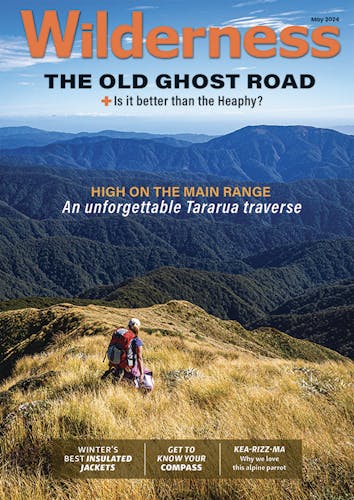Eugene Yeo’s passion is technical caving under Aotearoa’s marble mountains and limestone hills. With a background in rock climbing and canyoning, he especially enjoys vertical realms carved out by underground waterfalls, and sporty, bouldery navigation through subterranean streamways.
“What I pack largely depends on the objective,” he says. “Major factors include the amount of rope work and rigging anticipated, how wet and cold the cave is, and whether or not it’s an overnighter. Durability is key: our gear needs to withstand being hauled, thrown, kicked and dragged through rock, mud and water.”
Outer protection
My Aspiring Safety overalls, made from 1000-denier Cordura with reinforced patches on backside, knees and elbows, polar fleece-lined collar and built-in foam knee pads, provide durable protection against harsh cave environments. Garden gloves protect my hands on sharp rock and keep them warm.
Warmth
Depending on temperature, I wear one or two of Macpac’s geothermal long-sleeve shirt and pants baselayers, a neck gaiter and a beanie. For consistently wet caves with lots of deep pools and waterfalls, I use my 5mm Need Essentials wetsuit.
Keeping things dry
My 3.6L and 6L watertight kegs from Aspiring Safety work better than regular dry bags – they can take a beating and are perfect for storing fragile items such as cameras. They also double as bag flotation in deep water.
Food
My MSR PocketRocket 2 stove fits inside my Sea to Summit Alpha cookset – great for coffee and ramen breaks. Shoutout to Back Country Cuisine for sponsoring our FMC Youth Scholarship Expedition down Bulmer Cave on Mt Owen!
Personal technical gear
A single rope technique harness kit is necessary for vertical caving and typically comprises double cowstails, hand ascender, leg loops, chest harness, chest ascender and an abseil rack. Foot ascenders are optional for extra boost on longer pitches.
Ropes and rigging
Different objectives require different rigging materials, and it’s good to carry a spare 20–30m static rope, tubular webbing (anchors) and locking carabiners for any unexpected pitches or circumventing damaged fixed lines.
Footwear
Sturdy gumboots are excellent for caving as they are durable, grippy for climbing, provide ankle protection, are relatively cheap and keep feet dry in shallow pools; 3mm neoprene socks are great if wet feet are unavoidable. If we anticipate lots of water and consistent swimming, my Bestard Canyon Guide boots provide excellent drainage and grip on wet rock.
Pack
My Aspiring Safety 35L Cave Pack is absolutely bombproof. At 1400g, it’s on the heavy side, but worth it for the beating it takes. The minimalist 15l version is also great for smaller days.
Lighting
The Fenix HM70R is my primary light, with a 400hr runtime on the lowest setting and a 1600 lumen output. I have a Fenix HM65R (1400 lumens) as my backup, and a Fenix LR35R torch (10,000 lumens) for lighting up larger chambers or pools.
Emergencies
My MTDE Speleo Poncho is waterproof, heat-trapping, lightweight and reusable, and can be combined with multiple units to create a larger group shelter – ideal for any unexpected epics underground.







